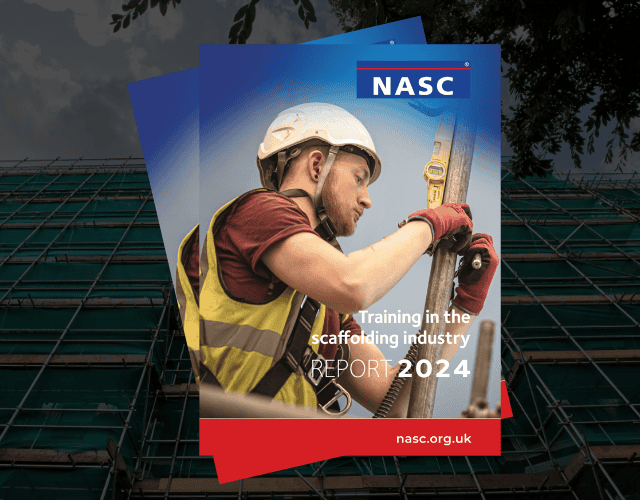Scaffolders Urged to Protect Swift Nests During Breeding Season
In response to recent incidents where scaffolding has obstructed swift nest sites, RSPB volunteer Kerry Dawson is issuing a heartfelt plea to scaffolding companies across the UK.
This summer, two alarming cases have been seen in Ramsgate and Eltham, where scaffolding unintentionally blocked the nests of swifts, a species now red-listed and at serious risk of extinction in the UK. Swifts are unique and remarkable birds that spend nearly all their lives in the air. Their ability to enter nesting sites at high speed through small gaps makes them particularly vulnerable to obstruction by scaffolding. Swifts cannot perch due to the lack of a ‘thumb’ claw, meaning they rely solely on their flight skills to access their nests.Legal and Conservation Urgency
Speaking to Scaffmag, Kerry Sabin-Dawson emphasised the legal ramifications of blocking swift nests. Obstructing these nests’ entry or exit routes is an offence under the Wildlife and Countryside Act 1981. With swift populations in steep decline, it is vital that scaffolding companies take proactive measures to ensure they do not inadvertently contribute to this crisis. “Nest sites are often hidden,” Dawson explains, “but there are signs to look out for, such as the calls of nestlings, droppings, or adult swifts trying to access the site. Even if you don’t see a nest, it doesn’t mean one isn’t there. That’s why it’s so important to check carefully before erecting scaffolding.”Guidance and Resources for Scaffolders
Dawson calls on scaffolders to avoid placing scaffolding around roofs or fascias between April and September, the critical swift breeding season. If scaffolding is unavoidable, she urges companies to inspect for potential nesting sites thoroughly. “Swifts can squeeze through the smallest of holes, so it’s crucial to be vigilant,” she adds. She also recommends using the RSPB’s Swift Mapper website (https://www.swiftmapper.org.uk/) to check for recorded nest sites, although she cautions that many nests remain unrecorded.
A Call to Action
Kerry Dawson notes that once scaffolders understand the unique situation swifts face, they are often very willing to make accommodations. “This is a collaborative effort,” she says. “By taking these small but significant steps, scaffolders can make a huge difference in the survival of these incredible birds.” For more information on how scaffolders can help protect swifts, visit RSPB’s website.Liddiard Scaffolding and LSS Deliver Success with Layher’s Keder XL Roof System
The Amelia Court project at Union Place in Worthing is a remarkable example of the successful integration of traditional scaffolding methods with modern, innovative solutions.
The project involved the complete replacement of the roof covering on a large, central vaulted roof of a care home, presenting a complex and ambitious challenge.
The building’s “U” shape, with West and East wings extending from each end, added to the complexity, but Liddiard Scaffolding, the scaffolding contractor on site, expertly managed these challenges.
 The combination of traditional scaffolding with Layher’s Keder XL Roof System illustrated how modern scaffolding technology can enhance traditional methods, resulting in a project that was both secure and efficient.
The temporary roof’s design allowed for easy installation and adaptability, perfectly meeting the project’s demands despite the site’s challenging constraints.
The combination of traditional scaffolding with Layher’s Keder XL Roof System illustrated how modern scaffolding technology can enhance traditional methods, resulting in a project that was both secure and efficient.
The temporary roof’s design allowed for easy installation and adaptability, perfectly meeting the project’s demands despite the site’s challenging constraints.
 Another significant challenge was maintaining continuous access to the care home’s main entrance while ensuring the safety of residents and staff. The project team, led by their experienced foreman, meticulously planned each project stage.
Their close coordination with care home management ensured minimal disruptions and upheld safety as the top priority throughout the project.
Another significant challenge was maintaining continuous access to the care home’s main entrance while ensuring the safety of residents and staff. The project team, led by their experienced foreman, meticulously planned each project stage.
Their close coordination with care home management ensured minimal disruptions and upheld safety as the top priority throughout the project.
 Their ability to overcome unexpected challenges, such as the presence of memorial Rose bushes and the proximity of a two-story office building along the car park boundary, demonstrated their professionalism and commitment to the project’s success.
The project was completed successfully, with McCarthy & Stone, the main contractor, expressing their satisfaction with the quality of the scaffolding work and the overall management of the project.
The successful completion of the central roof section led to additional orders for roof access scaffolding on the building’s West and East wings, further cementing the reputations of both Layher UK and Liddiard Scaffolding.
Their ability to overcome unexpected challenges, such as the presence of memorial Rose bushes and the proximity of a two-story office building along the car park boundary, demonstrated their professionalism and commitment to the project’s success.
The project was completed successfully, with McCarthy & Stone, the main contractor, expressing their satisfaction with the quality of the scaffolding work and the overall management of the project.
The successful completion of the central roof section led to additional orders for roof access scaffolding on the building’s West and East wings, further cementing the reputations of both Layher UK and Liddiard Scaffolding.
Traditional Meets Modern: The Scaffolding Structure
The main framework of the scaffolding structure for this project was built using traditional tube and fitting scaffolding. This method provided the strength and stability for the extensive work required on the care home’s roof. However, the project’s innovative aspect came from the use of Layher’s Keder XL Roof System, supplied by Layher UK. This advanced temporary roofing system was essential in providing full weather protection, covering an impressive 1,426 square meters. The combination of traditional scaffolding with Layher’s Keder XL Roof System illustrated how modern scaffolding technology can enhance traditional methods, resulting in a project that was both secure and efficient.
The temporary roof’s design allowed for easy installation and adaptability, perfectly meeting the project’s demands despite the site’s challenging constraints.
The combination of traditional scaffolding with Layher’s Keder XL Roof System illustrated how modern scaffolding technology can enhance traditional methods, resulting in a project that was both secure and efficient.
The temporary roof’s design allowed for easy installation and adaptability, perfectly meeting the project’s demands despite the site’s challenging constraints.
Liddiard Scaffolding and LSS: A Synergy in Execution
Liddiard Scaffolding’s role was critical to the project’s success, leveraging their extensive experience with traditional scaffolding and modern systems like Layher’s Keder XL Roof. The project required overcoming significant logistical challenges, particularly the restricted space for unloading and assembling materials in a small car park. A key element in managing these challenges was the involvement of Lifting & Scaffolding Services (LSS), Liddiard’s sister company. LSS provided the Hiab vehicles essential for transporting and precisely lifting materials, including assembling and placing the spine beams and temporary roof sections. As a company responsible for much of Liddiard Scaffolding’s transport requirements, LSS played a crucial role in ensuring that materials were delivered and positioned efficiently, allowing the project to proceed smoothly despite the confined working environment. Another significant challenge was maintaining continuous access to the care home’s main entrance while ensuring the safety of residents and staff. The project team, led by their experienced foreman, meticulously planned each project stage.
Their close coordination with care home management ensured minimal disruptions and upheld safety as the top priority throughout the project.
Another significant challenge was maintaining continuous access to the care home’s main entrance while ensuring the safety of residents and staff. The project team, led by their experienced foreman, meticulously planned each project stage.
Their close coordination with care home management ensured minimal disruptions and upheld safety as the top priority throughout the project.
Collaborative Success and Client Satisfaction
This project underscored the importance of collaboration between all stakeholders. Liddiard Scaffolding worked closely with Layher UK design engineers and the client’s management team to ensure that all modifications and adaptations were seamlessly integrated into the project plan. Their ability to overcome unexpected challenges, such as the presence of memorial Rose bushes and the proximity of a two-story office building along the car park boundary, demonstrated their professionalism and commitment to the project’s success.
The project was completed successfully, with McCarthy & Stone, the main contractor, expressing their satisfaction with the quality of the scaffolding work and the overall management of the project.
The successful completion of the central roof section led to additional orders for roof access scaffolding on the building’s West and East wings, further cementing the reputations of both Layher UK and Liddiard Scaffolding.
Their ability to overcome unexpected challenges, such as the presence of memorial Rose bushes and the proximity of a two-story office building along the car park boundary, demonstrated their professionalism and commitment to the project’s success.
The project was completed successfully, with McCarthy & Stone, the main contractor, expressing their satisfaction with the quality of the scaffolding work and the overall management of the project.
The successful completion of the central roof section led to additional orders for roof access scaffolding on the building’s West and East wings, further cementing the reputations of both Layher UK and Liddiard Scaffolding.
Final Thoughts
The Amelia Court project exemplifies the effective combination of traditional scaffolding methods with modern innovations like Layher’s Keder XL Roof System. Liddiard Scaffolding’s expertise and careful planning, supported by Lifting & Scaffolding Services (LSS) ’s logistical capabilities, ensured the project’s success. This collaboration not only met but exceeded the expectations of all involved, reinforcing Layher UK, Liddiard Scaffolding, and LSS’s reputations as leaders in their respective fields.PERI UK Marks 35th Anniversary
PERI UK recently marked a significant milestone, celebrating 35 years of successful operations in the UK construction industry.
The anniversary was celebrated in style, with employees across all six offices enjoying a special lunch event, highlighted by a hog roast at the company’s head office in Rugby. Since its inception in 1989, PERI UK has established itself as a leading name in temporary works solutions within the construction sector. As the eighth subsidiary under the global PERI Group, the company has steadily expanded its influence and offerings in the UK market. The journey began with its first project in 1990 when PERI played a pivotal role in the construction of the Queen Elizabeth II bridge. The company designed and supplied VARIO shutters for the wall formwork, complemented by its CB 240 climbing system, which facilitated pours at a height of five meters—an early demonstration of PERI’s engineering prowess. Over the past three and a half decades, PERI UK has built a strong reputation and achieved numerous milestones that underline its growth and commitment to innovation. Among these accomplishments is the £15 million redevelopment of its flagship office in Brentwood, further strengthening its presence in the UK. More recently, the acquisition of Mabey Hire has expanded PERI’s capabilities, allowing the company to offer an even wider range of services to its customers. Ian Hayes, Managing Director of PERI UK, expressed his gratitude and optimism during the anniversary celebrations. “PERI’s success over the past 35 years has been made possible by the unwavering support and dedication of our employees, along with the loyalty of our customers and supply chain partners,” Hayes remarked. “As we reflect on the company’s accomplishments spanning over three decades, I am filled with pride and optimism for the future, as I see so much potential in the years ahead. I want to extend my heartfelt thanks to everyone who has contributed to PERI’s journey thus far.”Altrad to Acquire Norwegian Industrial Firm
Altrad, a global leader in industrial services, has announced a voluntary cash offer to acquire all outstanding shares of Beerenberg AS, a prominent Norwegian provider of maintenance and modification services.
This strategic move aligns with Altrad’s ongoing efforts to expand its global footprint and enhance service offerings across various sectors. The transaction, expected to close by the end of 2024, is contingent upon receiving regulatory approvals and meeting other customary conditions. Altrad’s Co-CEO, Ran Oren, expressed enthusiasm about the potential acquisition, highlighting Beerenberg’s strong management team and impressive industry track record. “We have admired Beerenberg from a distance for many years and have been impressed by the achievements of the management team and their talented people,” said Oren. “Our objective is to build on this success by adding investment, skilled people, innovative products, and a broader range of services to support their clients’ ambitions.” Beerenberg, headquartered in Bergen, Norway, has been a key player in the maintenance and modification services sector for 47 years, particularly within the Norwegian Continental Shelf. The company also operates internationally, providing insulating products and a range of services throughout the petroleum industry’s lifecycle. The acquisition will bring Beerenberg’s 2,350 employees into the Altrad Group, where they will be integrated into Altrad’s extensive global network, which spans more than 55 countries. The move is seen as an opportunity for Beerenberg employees to further develop their careers within a larger, more diverse organization. Altrad, known for its multidisciplinary services and strong presence in the energy, power generation, oil & gas, and construction sectors, generated sales of €5.3 billion and an EBITDA of €674 million for the fiscal year ending 31 August 2023. The proposed acquisition underscores Altrad’s commitment to investing in businesses that share its vision and values, further solidifying its position as a leader in the industrial services market.Scaffolding Collapse in Cardiff Causes Major Damage at Industrial Estate
Scaffolding access and temporary edge protection at Trident Industrial Park in Cardiff collapsed on Monday, causing extensive damage to multiple vehicles parked below.
According to WalesOnline, the incident was triggered by strong winds and occurred near a gym and trampoline park, where the scaffolding was being used for ongoing construction. South Wales Fire and Rescue Service responded promptly, cordoning the area to prevent further damage and ensure public safety. Fortunately, no injuries were reported, but the businesses nearby, including the gym, experienced significant disruption. The sheeted scaffolding was part of a project to refurbish a unit within the industrial estate. Eyewitnesses described a sudden gust of wind that dislodged the scaffolding, sending it crashing down onto several cars parked outside the gym.

NASC and CISRS to Overhaul Scaffolding Training Following Eye-Opening 2024 Report
In a bold move that could reshape the scaffolding industry, the National Access & Scaffolding Confederation (NASC) has published its much-anticipated ‘Training in the Scaffolding Industry: Report 2024.’
The comprehensive report sheds light on the current state of training in the sector, revealing both opportunities and urgent areas for improvement. NASC, in partnership with the Construction Industry Scaffolders Record Scheme (CISRS), has pledged to take immediate action and use the report’s findings to drive substantial reforms. The survey, conducted earlier this year, provides an in-depth snapshot of the scaffolding industry as it stood in the first quarter of 2024. With 103 responses from 97 organisations, the report highlights significant challenges facing the sector, including nearly 2,000 job vacancies in critical scaffold roles, with Part 2 scaffolders being in the highest demand. The findings underscore the urgent need for strategic interventions to address these workforce shortages and regional disparities in training accessibility. One of the most striking revelations from the survey is the varying levels of satisfaction with training courses, with larger companies generally expressing higher contentment. However, a consistent theme among respondents was the call for enriched course content, particularly in leadership skills and mental health awareness. Additionally, the need for more immediate and constructive feedback from training providers was a recurring concern, underscoring the demand for a more responsive and dynamic training environment.“The membership has spoken, and NASC is listening.”NASC’s Training and Education Committee is set to take these insights seriously, aiming to close the gaps identified in the training landscape. The organisation has expressed gratitude to the survey participants and is committed to translating these findings into actionable strategies to future-proof the scaffolding industry.

Scaffolding Brilliance: How Allied Access and BDS Helped Revive Blackburn’s Victoria Building
Nestled in the heart of Blackburn, the Victoria Building stands as a grand testament to the town’s rich history. Built in 1888, this Grade II listed structure has witnessed over a century of change, and now, it faces one of its most significant transformations yet.
A team of experts from Allied Access and Buckley Design Solutions (BDS) are spearheading this ambitious, multi-million-pound restoration of Blackburn College’s Victoria Building. Their ingenuity and dedication are breathing new life into this historic landmark.
The Victoria Building’s red-brick facade and ornate details have long been symbols of Blackburn’s architectural heritage. However, time has taken its toll, and the building now requires meticulous internal and external restoration to preserve its structural integrity and aesthetic beauty.
This project, managed by construction giants Bam Construction Ltd., isn’t just about renovation; it’s about respecting and maintaining the historical essence of an irreplaceable piece of Blackburn’s identity.

 To shield the building and workers from Blackburn’s unpredictable weather, highly skilled scaffolders from Allied installed a comprehensive temporary roof. Spanning 44 meters and supported by a central spine beam through the North light well, this roof protects and enables continuous restoration work.
To shield the building and workers from Blackburn’s unpredictable weather, highly skilled scaffolders from Allied installed a comprehensive temporary roof. Spanning 44 meters and supported by a central spine beam through the North light well, this roof protects and enables continuous restoration work.
 BDS told Scaffmag that the restoration project presented a series of complex challenges that required innovative solutions. Initial design plans were revised to address the building’s structural limitations and ensure the scaffolding’s effectiveness.
Revision A: The first significant design revision removed ties from the North, East, and South elevations, replacing them with buttresses. However, due to structural constraints, the West elevation remained fully tied and supported by bespoke cantilever brackets.
Revision B: A critical breakthrough came with introducing a central core tower in the North light well, distributing the load more effectively. This central tower, combined with spine beams running from East to West, significantly reduced external leg loads. A concrete raft foundation further facilitated load distribution, eliminating the need for additional support weights, or “kentledge.”
BDS told Scaffmag that the restoration project presented a series of complex challenges that required innovative solutions. Initial design plans were revised to address the building’s structural limitations and ensure the scaffolding’s effectiveness.
Revision A: The first significant design revision removed ties from the North, East, and South elevations, replacing them with buttresses. However, due to structural constraints, the West elevation remained fully tied and supported by bespoke cantilever brackets.
Revision B: A critical breakthrough came with introducing a central core tower in the North light well, distributing the load more effectively. This central tower, combined with spine beams running from East to West, significantly reduced external leg loads. A concrete raft foundation further facilitated load distribution, eliminating the need for additional support weights, or “kentledge.”
 Collaboration with structural engineers from Curtins and Wentworth House Partnerships led to the development of a ring beam system, redistributing localised loads and ensuring stability. The use of 3D design models by BDS allowed the scaffolders to visualise and execute this intricate scaffolding system with precision.
Collaboration with structural engineers from Curtins and Wentworth House Partnerships led to the development of a ring beam system, redistributing localised loads and ensuring stability. The use of 3D design models by BDS allowed the scaffolders to visualise and execute this intricate scaffolding system with precision.
 Key stages of the project highlighted the team’s expertise and adaptability:
Setting the Scaffolding Base: Aligning the scaffolding base correctly was paramount, considering the complex ties into the newly designed concrete raft foundation. The team’s meticulous approach ensured a stable foundation.
Cantilever Brackets Installation: Custom-designed cantilever brackets were carefully installed to support the West elevation without compromising its historical integrity.
Spine Beams Installation: Positioned with precision, the spine beams supported the temporary roof, providing a safe and effective solution for weather protection.
Temporary Roof Installation: The installation of the temporary roof ensured comprehensive coverage, allowing restoration work to proceed uninterrupted, regardless of weather conditions.
Key stages of the project highlighted the team’s expertise and adaptability:
Setting the Scaffolding Base: Aligning the scaffolding base correctly was paramount, considering the complex ties into the newly designed concrete raft foundation. The team’s meticulous approach ensured a stable foundation.
Cantilever Brackets Installation: Custom-designed cantilever brackets were carefully installed to support the West elevation without compromising its historical integrity.
Spine Beams Installation: Positioned with precision, the spine beams supported the temporary roof, providing a safe and effective solution for weather protection.
Temporary Roof Installation: The installation of the temporary roof ensured comprehensive coverage, allowing restoration work to proceed uninterrupted, regardless of weather conditions.
 The Victoria Building restoration is more than a project; it’s a labour of love and a testament to the expertise and dedication of Allied Access and Buckley Design Solutions. Their innovative approach and meticulous planning have helped preserve a piece of Blackburn’s heritage and set a new benchmark for future scaffolding and restoration projects.
In reviving the Victoria Building, the team has woven a story of collaboration, innovation, and respect for history. Their work ensures that this architectural gem will continue to grace Blackburn’s skyline for generations to come.
The Victoria Building restoration is more than a project; it’s a labour of love and a testament to the expertise and dedication of Allied Access and Buckley Design Solutions. Their innovative approach and meticulous planning have helped preserve a piece of Blackburn’s heritage and set a new benchmark for future scaffolding and restoration projects.
In reviving the Victoria Building, the team has woven a story of collaboration, innovation, and respect for history. Their work ensures that this architectural gem will continue to grace Blackburn’s skyline for generations to come.
An Ingenious Scaffolding Solution
Allied Access and BDS took on the Herculean task of designing and erecting a scaffolding system that would support the restoration work while protecting the delicate structure. From the outset, it was clear that this wouldn’t be a typical scaffolding project. To avoid damaging the building’s facade, BDS designed a freestanding scaffold system for the North, East, and South elevations. This approach ensured stability without relying on the fragile walls of the historic structure. The West elevation, however, required a different strategy. Here, bespoke cantilever brackets were used due to the low load-bearing capacity of the neighboring roof.
 To shield the building and workers from Blackburn’s unpredictable weather, highly skilled scaffolders from Allied installed a comprehensive temporary roof. Spanning 44 meters and supported by a central spine beam through the North light well, this roof protects and enables continuous restoration work.
To shield the building and workers from Blackburn’s unpredictable weather, highly skilled scaffolders from Allied installed a comprehensive temporary roof. Spanning 44 meters and supported by a central spine beam through the North light well, this roof protects and enables continuous restoration work.
Overcoming Design Challenges
 BDS told Scaffmag that the restoration project presented a series of complex challenges that required innovative solutions. Initial design plans were revised to address the building’s structural limitations and ensure the scaffolding’s effectiveness.
Revision A: The first significant design revision removed ties from the North, East, and South elevations, replacing them with buttresses. However, due to structural constraints, the West elevation remained fully tied and supported by bespoke cantilever brackets.
Revision B: A critical breakthrough came with introducing a central core tower in the North light well, distributing the load more effectively. This central tower, combined with spine beams running from East to West, significantly reduced external leg loads. A concrete raft foundation further facilitated load distribution, eliminating the need for additional support weights, or “kentledge.”
BDS told Scaffmag that the restoration project presented a series of complex challenges that required innovative solutions. Initial design plans were revised to address the building’s structural limitations and ensure the scaffolding’s effectiveness.
Revision A: The first significant design revision removed ties from the North, East, and South elevations, replacing them with buttresses. However, due to structural constraints, the West elevation remained fully tied and supported by bespoke cantilever brackets.
Revision B: A critical breakthrough came with introducing a central core tower in the North light well, distributing the load more effectively. This central tower, combined with spine beams running from East to West, significantly reduced external leg loads. A concrete raft foundation further facilitated load distribution, eliminating the need for additional support weights, or “kentledge.”
 Collaboration with structural engineers from Curtins and Wentworth House Partnerships led to the development of a ring beam system, redistributing localised loads and ensuring stability. The use of 3D design models by BDS allowed the scaffolders to visualise and execute this intricate scaffolding system with precision.
Collaboration with structural engineers from Curtins and Wentworth House Partnerships led to the development of a ring beam system, redistributing localised loads and ensuring stability. The use of 3D design models by BDS allowed the scaffolders to visualise and execute this intricate scaffolding system with precision.
Navigating Operational Hurdles
Logistical and operational challenges were ever-present, but the team’s meticulous planning and coordination ensured smooth execution. Strict Timelines: With a tight schedule to adhere to, detailed project planning and regular progress meetings kept the project on track. Logistical Coordination: The site’s historical nature demanded careful planning for the transportation and placement of materials. Coordination with Blackburn College and local authorities helped minimise disruptions. Resource Management: Securing experienced scaffolding operatives and high-quality materials was crucial. Continuous training ensured the team’s efficiency and adherence to high standards.The Path to Success
 Key stages of the project highlighted the team’s expertise and adaptability:
Setting the Scaffolding Base: Aligning the scaffolding base correctly was paramount, considering the complex ties into the newly designed concrete raft foundation. The team’s meticulous approach ensured a stable foundation.
Cantilever Brackets Installation: Custom-designed cantilever brackets were carefully installed to support the West elevation without compromising its historical integrity.
Spine Beams Installation: Positioned with precision, the spine beams supported the temporary roof, providing a safe and effective solution for weather protection.
Temporary Roof Installation: The installation of the temporary roof ensured comprehensive coverage, allowing restoration work to proceed uninterrupted, regardless of weather conditions.
Key stages of the project highlighted the team’s expertise and adaptability:
Setting the Scaffolding Base: Aligning the scaffolding base correctly was paramount, considering the complex ties into the newly designed concrete raft foundation. The team’s meticulous approach ensured a stable foundation.
Cantilever Brackets Installation: Custom-designed cantilever brackets were carefully installed to support the West elevation without compromising its historical integrity.
Spine Beams Installation: Positioned with precision, the spine beams supported the temporary roof, providing a safe and effective solution for weather protection.
Temporary Roof Installation: The installation of the temporary roof ensured comprehensive coverage, allowing restoration work to proceed uninterrupted, regardless of weather conditions.
“Having been involved in the scaffold industry for almost 30 years, this scaffold design is the most complex I’ve worked on”
Achieving Recognition
As the Victoria Building restoration progresses toward its scheduled completion in September 2024, the project has already garnered widespread acclaim for its innovative design and seamless execution. Kevin Walsh, Senior Design Engineer at BAM Construct UK Ltd, remarked, “The design challenges were formidable, but the BDS team rose to the occasion. Their proactive collaboration with BAM’s site team and the Project Structural Engineer was instrumental in developing a workable design. Without this close cooperation, the temporary roof would have been an impossible feat.” Lee Buckley, Managing Director of Buckley Design Solutions, reflected on the project’s complexity, stating, “In nearly 30 years in the scaffolding industry, this design stands out as the most intricate I’ve ever worked on. The ability of the scaffolding team to execute the plan ahead of schedule is truly commendable.” Steve Bannister, Operations Director at Allied Access, echoed these sentiments, adding, “With over 40 years in the scaffolding industry across various sectors, this project has been a particularly rewarding experience. Early engagement with BAM, the client, and BDS was key to bringing this complex plan to life, and the collaborative effort has been nothing short of remarkable. “The Directors are immensely proud of the Allied team, whose professionalism and swift execution of this exceptional scaffolding structure deserve high praise.” BAM Construction Manager Mick Donoghue and Senior Project Manager Mark Hardisty concluded: “The Victoria Building Project presented a plethora of complex issues to overcome. Being a Grade II Listed structure requiring a complete reroof, it was imperative that the correct solution to safeguard these finishes whilst the works were being carried out was developed to prevent further damage to the internal fabric. With the early engagement of our supply chain partners, Allied Access and BDS, the team has worked hand in hand with BAM’s design and management teams to develop a scheme that achieves this without impacting on the listed façade.” “Our thanks go out to BDS and all involved in working so collaboratively to overcome the many challenges along the way.”A Vision Realised
 The Victoria Building restoration is more than a project; it’s a labour of love and a testament to the expertise and dedication of Allied Access and Buckley Design Solutions. Their innovative approach and meticulous planning have helped preserve a piece of Blackburn’s heritage and set a new benchmark for future scaffolding and restoration projects.
In reviving the Victoria Building, the team has woven a story of collaboration, innovation, and respect for history. Their work ensures that this architectural gem will continue to grace Blackburn’s skyline for generations to come.
The Victoria Building restoration is more than a project; it’s a labour of love and a testament to the expertise and dedication of Allied Access and Buckley Design Solutions. Their innovative approach and meticulous planning have helped preserve a piece of Blackburn’s heritage and set a new benchmark for future scaffolding and restoration projects.
In reviving the Victoria Building, the team has woven a story of collaboration, innovation, and respect for history. Their work ensures that this architectural gem will continue to grace Blackburn’s skyline for generations to come. Scafom-rux UK Announced as Key Sponsor for ScaffCon24
Scafom-rux UK Ltd, a global provider of system scaffolding solutions, has announced its role as the headline sponsor for ScaffCon24.
The event, organised by the Scaffolding Association and regarded as one of the UK’s premier scaffolding and access industry conferences, will occur on October 11th at The Belfry Hotel and Resort. This strategic partnership highlights Scafom-rux’s unwavering commitment to advancing safety, technological innovation, and best practices within the sector. The company’s involvement as the headline sponsor reinforces its dedication to the industry and aligns with its mission to drive positive change and foster collaboration among professionals.“ScaffCon24 is a vital event for our industry”Andrew Smith, Managing Director of Scafom-rux UK, expressed his enthusiasm for the event, stating, “ScaffCon24 is a vital event for our industry, and as the headline sponsor, we are delighted to contribute to its success. Our mission aligns perfectly with the conference’s focus on safety, innovation, and collaboration. We look forward to engaging with fellow professionals and showcasing our latest solutions.” ScaffCon24 is set to attract company owners, industry experts, and scaffolding professionals from across the UK. The conference will feature thought-provoking sessions led by some of the industry’s most influential leaders, providing delegates with valuable insights into critical topics such as the latest safety regulations, best practices for working at height, and the evolving landscape of temporary works design and fleet vehicle operations. In addition to sponsoring the event, Scafom-rux UK will exhibit, offering delegates a chance to explore its comprehensive range of scaffolding products, accessories, and rental options. Attendees will also have the opportunity to engage directly with the company’s team of experts, who will be on hand to discuss the latest trends and innovations in the scaffolding industry. ScaffCon24 presents an invaluable opportunity for scaffolding professionals to expand their knowledge, network with peers, and discover the latest advancements shaping the industry’s future. As the scaffolding sector evolves, events like ScaffCon24 are crucial in ensuring that companies remain at the forefront of safety, efficiency, and technological progress. For more information and to book your tickets, visit the official ScaffCon24 website: www.scaffoldconference.co.uk.











